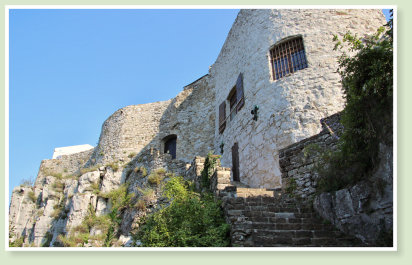

Coast and Karst
Socerb castle, Hrastovlje church & frescoes, Sečovlje salt
fields (soline), Piran and Koper
The Slovenian coast is small and steeped in a history of battles with neighbouring Italy and Croatia..

Socerb Castle
The 13th century Socerb Castle is perched on the edge of a 300
meter high Karst rock and offers a wonderful view of Koper and the
Bay of Trieste Gulfs. Due to its location, Socerb Castle was an
important stronghold in Illyrian times, modified into a fortress in
the Roman period.
The castle has changed owners several times. In 1780 it was badly
damaged by fire. It now operates as a venue and restaurant for
weddings..


Hrastovlje Church of the Holy
Trinity
This small 13th century church
is surrounded by a stone
encampment wall into which
the locals fled for protection
during the Turkish attacks in
the 16th century. (These
defensive architectures are found throughout Slovenia and are
called ‘tabor’) The interior of the church is full of amazing
frescoes painted in 1490 by Johannes de Castua, some of which
include letters in the Glagolitic script. They were hidden under
plaster for a long time and discovered in 1949 then carefully
restored.
There are numerous frescos with saints and prophets and scenes
of farm work symbolising the 12 months. There is also a
depiction of the Passion series on the north wall with the journey
and adoration of the Magi. Full-figured images of the Apostles are
painted in niches in the apse, where the Throne of Grace is
centrally positioned.
On the south wall the most famous scene of medieval frescos in
Slovenia is painted: - a continued Dance of Death. The rare scene
shows people dancing with skeletons before the grave. There is a
line of people of different classes in their typical clothing: from a
baby and beggar to the king and the pope; all of them are led by
skeletons though life to the grave.
Sečovlje Salt Pans, Salina
Nature Park
On the short 47km Slovenian Coast there are now only a few
coastal wetlands. At one time there were more, as the delta
marshes and bays were shaped into the salt pans, on the verges of
Koper, Izola, Strunjan, Lucija and Sečovlje.
Today the working Sečovlje salt pans are the largest coastal marsh
wetlands (650 hectares), and at the same time the most important
Slovenian area from an ornithological point of view. 288 species of
birds have been seen of which 90 are nesting there.
In 1993, Salina became the first Slovene wetland, inscribed on the
list of internationally important marshes under the auspices of the
Ramsar Convention. In 2001, the Government of the Republic of
Slovenia proclaimed the area of Sečovlje Salina a nature park and
the Museum of Salt-making a cultural monument of national
importance.





Piran
A pretty, medieval Venetian town on a peninsula jutting into the
Adriatic, it is centred around the lovely Tartini Square and
overlooked by an imposing and beautiful hilltop cathedral. Tartini
Square is named after the famous 18th century composer and
violinist who was born in Piran. The town is a maze of charming
medieval streets, alleys and squares.
Recorded as a fortified town under Byzantine rule as early as the
7th century, Piran has an abundance of beautiful historic
buildings, both from the period of Venetian and Austrian rule,
and a fantastic position on a peninsula surrounded on 3 sides by
the Adriatic. The original walls - built to protect the town from
attacks by the Ottomans are still partially in existence and it is
possible to climb the walls and tower to see the wonderful views
over the town.
Overlooking the town is the beautiful St Georges Cathedral which
offers wonderful views of the Gulf of Trieste stretching from the
Italian to the Croatian coasts.
Koper
We ended our tour with a walk through historical Koper, the most
important city and port on the Slovenian coast. It is 5km from the
border with Italy and is officially a bi-lingual city with both Slovene
and Italian as official languages.
Koper's 15th-century Praetorian Palace is located on the city square.
It was built from two older 13th-century houses that were connected
by a loggia, rebuilt many times, and then finished as a Venetian
Gothic palace.
The city's Cathedral of the Assumption was built in the second half of
the 12th century and has one of the oldest bells in Slovenia (from
1333), cast by Master Jakob in Venice. The upper terrace is
periodically open and offers a great view of the Bay of Trieste. In the
middle of it hangs the Sacra Conversatione painting from 1516, one
of the best Renaissance paintings in Slovenia, made by Vittore
Carpaccio.











































